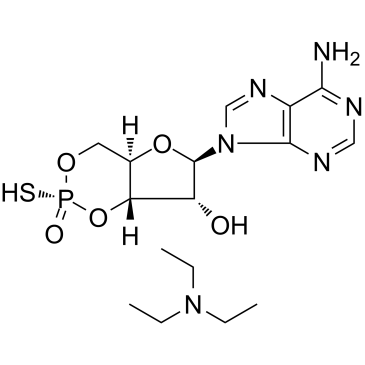151837-09-1
| Name | Rp-Adenosine 3′,5′-cyclic monophosphorothioate triethylammonium salt hydrate |
|---|---|
| Synonyms |
MFCD03703495
cAMPS-Rp,triethylammonium salt |
| Description | Rp-cAMPS triethylammonium salt is an analog of cAMP which acts as a potent, competitive and cell-permeable antagonist of cAMP-induced activation of cAMP-dependent PKA I and II (Kis of 6.05 µM and 9.75 µM, respectively). Rp-cAMPS triethylammonium salt is resistant to hydrolysis by phosphodiesterases[1][2][3][4][5]. |
|---|---|
| Related Catalog | |
| Target |
Ki: 6.05 µM (PKA I) and 9.75 µM (PKA II)[1] |
| In Vitro | A membrane-permeable competitive cAMP antagonist (Rp-cAMPS) that blocks PKA activation by binding to the regulatory subunits without dissociating the kinase holoenzyme also inhibits synaptic plasticity but has no effect on normal synaptic transmission[1]. |
| In Vivo | Rp-cAMPS (10 μM, 15 min) decreases the monosynaptic EPSCs evoked at the PB-CeLC and BLA-CeLC synapses in slices from arthritic rats but not in control neurons from normal animals. The inhibitory effect of Rp-cAMPS is significant compared to predrug (ACSF) control values obtained in the same neurons[1]. |
| References |
| Melting Point | 212 - 213 ℃ |
|---|---|
| Molecular Formula | C16H27N6O5PS |
| Molecular Weight | 446.46200 |
| Exact Mass | 446.15000 |
| PSA | 186.46000 |
| LogP | 2.04940 |
